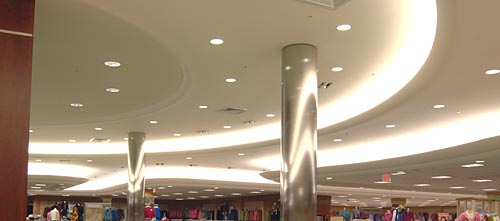The Fourth Source: Light-Emitting Diodes (LEDs) for General Illumination
Â
Â
4. Lumen Output. LED lumen output can vary as much as 20 percent from one LED to the next within a given bin. In addition, LED light fixtures commonly use multiple LEDs to achieve the quantity of light required for the intended application. With no standard, lighting manufacturers can state the low or high of this range, the average, or some other lumen value. Also, the initial lumens published apply only for the first few seconds of illumination. That's problematic because LEDs will lose 5 percent to 10 percent of their initial lumens within a few seconds of illumination due to thermal stabilization. Another variable: The initial loss can be as much as 20 percent if the fixture design has not adequately factored in thermal management requirements. Architects need to be conservative and "de-rate" the lumens to account for these two variables.
5. Ambient Temperature. An LED's performance is directly dependent upon the temperature at its junction (the region directly behind the diode). LED manufacturers publish maximum allowable junction temperatures to ensure optimal performance of the LED itself. Generally, the cooler the better; when pushed to higher temperatures, LEDs lose life and light output. This means the lighting specifier must understand the maximum ambient temperature the manufacturer recommends for a given fixture.
6. Wattage Consumption. LEDs vary in the turn-on voltage, which means the amount of energy they consume fluctuates. Those in the same bin may have input watt consumption that varies by as much as 20 percent or more from the typical value published by the manufacturer. Consumption will also vary based on the amount of current being delivered to the LEDs. The American Society of Heating, Refrigerating and Air-conditioning Engineers (ASHRAE) publishes power densities for lighting systems, but the goup has yet to determine how to calculate power densities (lumens per watt) for LEDs. For that reason, it is best to use the average until this is formalized in code. The best practice: Refer to the lighting manufacturer's specifications for advice on how to calculate the power draw of an LED fixture.
LED fixture selection and specification
Because of the lack of uniform standards for LEDs, there are two important words for lighting designers and architects to remember in specifying SSL: Choose wisely.
"We're all on the honor system," says Ron Newbold, an IESNA member and a senior product manager for Prescolite, a division of Hubbell Lighting. "Architects need to know there are no standards on how products work, and how manufacturers test them and report performance critieria." For example, Newbold emphasizes the fact that published performance data may not be consistent from one product cut sheet to the next. A product's rated life may be given simply as 100,000 hours or described as how much light a fixture produces when the light output declines to an unacceptable level, such as "50,000 hours at 70 percent lumen maintenance." For most general illumination applications, knowing a fixture's lumen maintenance is likely more important than knowing its full rated life, as the lumen levels determine the product's useful service life.
In general, LEDs last a very long time. Because of this, typical architectural specs for lighting fixtures tend toward more durable, longer-lasting products using higher-quality materials than one might associate with other lighting sources. As one architect explains, "An LED module in a cheap fixture defeats the purpose."
In addition, some manufacturers recommend the use of a dimmer for installations of any fixtures, arrays, strips, or clusters of LED products that include a total of 60 or more individual LEDs. This is true whether or not the installation is designed to have a dimming function for use by the building operator. The reason is that the dimmer contains a pulse-width-modulation (PWM) device that helps extend the useful life of the LEDs. (In some cases, it may also automatically activate the warranty for the fixture or LED source.)
Â
Â
|
Â
Light level and quality for LEDs
Light-level recommendations for LED fixtures are based on the the Illuminating Engineering Society of North America (IESNA) publication, IESNA Handbook. The light levels are defined not only by the lumens produced within the luminaire, but rather how much light exits and where it is delivered.
Essentially, LEDs are like small directional lamps that are combined in multiples for a given application. This adds another challenge for general illumination, as the hot points of light need to contribute to a uniform light distribution. For this reason, fixture optics are critical to luminaire and lighting system performance. A 6-inch downlight, for example, may incorporate ten LEDs, each in its own parabolic reflector with a dimpled or tooled surface to produce an overall diffused, uniform illuminance.
Â










